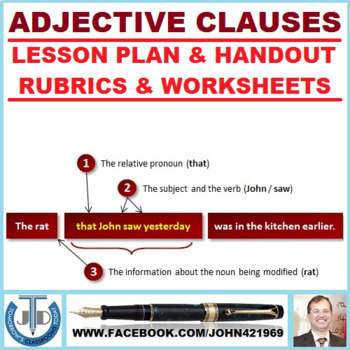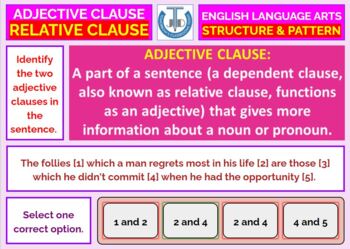ADJECTIVE CLAUSE OR RELATIVE CLAUSE - UNIT LESSON PLAN
JOHN DSOUZA
1.1k Followers
Grade Levels
2nd - 10th
Subjects
Resource Type
Standards
CCSSL.2.1e
CCSSL.2.6
CCSSL.3.1a
CCSSL.3.1g
CCSSL.7.1
Formats Included
- Word Document File
Pages
22 pages
JOHN DSOUZA
1.1k Followers
Also included in
- This bundle of 5 products (Unit Lesson Plans) is perfect for teaching Clauses - Noun Clause, Adjective Clause, Adverb Clause and Relative Clause. These no prep activities would be great for ELA lessons or ELA centers. Your students will love these well-planned exercises for student engagement.AfterPrice $11.20Original Price $16.00Save $4.80
- These bundled resources are perfect for teaching Clauses - Adjective or Relative Clause. These no prep activities would be great for English lessons or English centers. Your students will love these ELA Boom Cards, Google Slides, PPT, Unit Plan, Worksheets and Scaffolding Notes.After completing thisPrice $12.60Original Price $18.00Save $5.40
Description
This Unit Plan is perfect for teaching Clauses - Adjective Clause or Relative Clause. These no prep activities would be great for ELA lessons or ELA centers. Your students will love these exercises that are carefully planned for student engagement.
After attempting these New Bloom’s Taxonomy-based activities students will be able to:
- Define a clause and its components.
- List the properties of relative clauses with examples.
- Explain the role of relative pronouns and relative adverbs in forming adjective clauses.
- Identify the adjective clauses used as essential and non-essential information.
- Exercise error identification to ensure that adjective clauses are placed correctly and they are not dangling.
- Use adjective clauses in writing to vary sentence structure.
This Download Includes:
SESSION 1: REMEMBERING
- EXERCISE 1: Match the terms with their meaning.
SESSION 2: UNDERSTANDING
- EXERCISE 2: Watch the video – Adjective Clauses – to answer the following question.
- 1. Define of an adjective clause with two examples. Identify the nouns or pronouns modified, adjective clauses and how they function in the sentences.
- 2. List the types of adjective clauses with two examples each. Identify the nouns or pronouns modified, adjective clauses, punctuation rules and their function.
- 3. List the uses of relative pronouns with examples. Identify the nouns or pronouns modified, uses of relative pronouns, verbs and adjective clauses.
- EXERCISE 3: Review the properties of relative clauses and identify the elements from the examples.
- EXERCISE 4: Take the following quiz to demonstrate your understanding of adjective clauses.
SESSION 3: APPLYING
- EXERCISE 5: Identify the relative pronouns or relative adverbs in the following adjective clauses based on their functional classification in the following examples.
- EXERCISE 6: Identify the relative pronouns or adverbs used to form adjective clauses – Part 1-2.
SESSION 4: ANALYSING
- EXERCISE 7: Identify the placement (embedded or placed last) of adjective clauses based on their structural classification in the following examples.
- EXERCISE 8: Decide the type of adjective clauses used in sentences based on their functions.
- EXERCISE 9: Identify the adjective clauses in the given text – Part 1-2.
- EXERCISE 10: Fill in the blanks with appropriate relative pronouns, relative adverbs or adjective clauses.
- EXERCISE 11: Analyse the use of adjective clause in writing – Part 1-2.
SESSION 5: EVALUATING
- EXERCISE 12: Review the common errors writers make due to misplaced and dangling modifiers in the following examples.
- EXERCISE 13: Exercise error identification to ensure that all modifiers are placed correctly and there are no dangling modifiers – Part 1-3.
SESSION 6: CREATING
- EXERCISE 14: Choose any one of the following to demonstrate your writing skills using adjective clauses.
Here are some other possible uses for these in your classroom:
- To challenge early finishers
- For effective tutoring
- As ESL stations and sub tubs
- As holiday work and homework
- For small group collaborations
- For an end of unit assessments
- For reinforcement and enrichment
More Clauses Resources by the same Author:
This is what teachers say about these resources:
- DIARY WRITING LESSON AND RESOURCES - Comment from shiroitonbo: "Students loved this in our diary writing unit. Will use again in future." Rating: 5/5 (extremely satisfied)
- COMPARE AND CONTRAST INFORMATION TEXT LESSON AND RESOURCES - Comment from Vilma Rivera: "Great lesson, especially for those students struggling with the concept." Rating: 5/5 (extremely satisfied)
- WRITING A BIOGRAPHY: LESSON AND RESOURCES - 6 SESSIONS - Comment from Rhiannon Thomas: "I used this with Grade 7 International school students. It was a great resource and helped introduce the topic of biographies and autobiographies." Rating: 4/5 (very satisfied)
- PREFIXES AND SUFFIXES: UNIT LESSON PLAN AND RESOURCES - Comment from Caffeinate Educate Repeat: "Great resource!" Rating: 5/5 (extremely satisfied)
- WRITING A BIOGRAPHY: LESSON AND RESOURCES - 6 SESSIONS - Rhiannon Thomas: I used this with Grade 7 International school students. It was a great resource and helped introduce the topic of biographies and autobiographies. Rating: 4/5 (very satisfied)
- PARTS OF SPEECH: LESSON PLAN AND WORKSHEETS WITH ANSWERS - Denise Ebersbach: "Very through and great resource for my grammar unit." Rating: 4/5 (very satisfied)
- COMIC STRIPS CREATIONS LESSON AND RESOURCES - Great for unit on visual literacy, media texts, comics etc. Good print-outs in different formats were used to give them choice in telling their "hero" story (our theme) via comic strip boxes. - Roslyn Elkington. Rating: 5/5 (extremely satisfied)
- COLONS AND SEMICOLONS LESSON AND RESOURCES - Sharon Miller: "Great punctuation resource!" Rating: 5/5 (extremely satisfied).
- PRONOUN TYPES: LESSON PLAN AND RESOURCES - Melissa Daniels: "Very useful in my classroom as part of Pronouns instruction." Rating: 4/5 (very satisfied).
Customer Tips: How to get TPT credit to use for future purchases
- Follow me HERE to get notified of updates, sales, free resources and new products.
- Please go to your My Purchases page (you may need to LOG IN). Beside each purchase, you'll see a Provide Feedback button. Simply click it and you will be taken to a page where you can give a quick rating and leave a short comment for the product.
- Each time you give feedback, TPT gives you feedback credits that you use to lower the cost of your future purchases.
- I value your feedback greatly as it helps me determine which products are most valuable for your classroom so I can create more for you.
- Look for the green star next to my store logo and click it to become a FOLLOWER. You will now receive email updates about this store. Be the first to know about my new discounts, freebies and product launches.
Find Me Here:
- TPT Store - JOHN DSOUZA
- Pinterest - JOHN DSOUZA
- Facebook - TOMORROW’S CLASSROOM TODAY
- Instagram - JOHN421969
- Twitter - JOHN421969
- Blog - TOMORROW’S LESSONS TODAY
Total Pages
22 pages
Answer Key
Included with rubric
Teaching Duration
1 hour
Report this resource to TPT
Reported resources will be reviewed by our team. Report this resource to let us know if this resource violates TPT’s content guidelines.
Standards
to see state-specific standards (only available in the US).
CCSSL.2.1e
Use adjectives and adverbs, and choose between them depending on what is to be modified.
CCSSL.2.6
Use words and phrases acquired through conversations, reading and being read to, and responding to texts, including using adjectives and adverbs to describe (e.g., When other kids are happy that makes me happy).
CCSSL.3.1a
Explain the function of nouns, pronouns, verbs, adjectives, and adverbs in general and their functions in particular sentences.
CCSSL.3.1g
Form and use comparative and superlative adjectives and adverbs, and choose between them depending on what is to be modified.
CCSSL.7.1
Demonstrate command of the conventions of standard English grammar and usage when writing or speaking.







